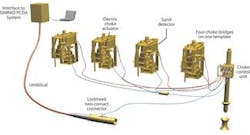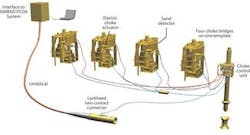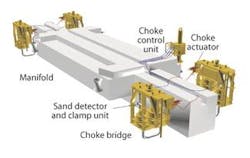Electric actuators simplify subsea distribution systems
Vidar Sten-Halvorsen
FMC Kongsberg Subsea
Electric actuator technology provides simpler subsea distribution systems and eliminates consumption and contamination of hydraulic fluids.
A request from Statoil to upgrade the Statfjord subsea production system accelerated FMC Kongsberg Subsea's development of electrical actuators in late 2001.
Inherent environmental and functional system advantages will expand the application of this new technology.
Statoil installed the 16-well Statfjord North and East subsea production system in 1994. There were no remote controls for subsea chokes or remote monitoring for sand detectors at the wellheads. The company performed adjustment of subsea chokes from a supply vessel using ROV torque tools and ROV-monitored sand detectors.
As the water content in the production increased, the subsea chokes needed more frequent adjustment. Statoil decided to install an electric choke control and sand detection system to resolve this challenge. The company installed the first prototype in December 2001; the full 16-well system was completed in September 2002 and has been in continuous operation since then.
FMC retrofitted the electric choke control system without shutting down production and without interfering with the existing electro-hydraulic control system. Rechargeable subsea batteries made this possible. The batteries drive the electric actuators and are integrated with the electric communication system through the existing umbilical. This technology has demonstrated its suitability for upgrading and modifying existing fields for improved functionality as operational parameters change over the fields' lifetime.
null
Design objectives
To avoid losing production, FMC designed the new system for installation without retrieving subsea control modules or choke bridges. An operator interface with the same look and feel as the original topside system was developed to ensure user-friendliness for the new functionality.
The system operates on existing communication lines on a different center frequency, "invisible" to the existing communication modems. Communication links to Kongsberg, Norway, offered the development team online monitoring and the opportunity to diagnose the new system.
The risk of accidental damage to the chokes was minimized through the use of torque limiting shear pins in the ROV-retrievable actuators. All of the subsea equipment was designed to be installed with ROV support.
Flexibility was a key design objective. System components can be used as building blocks in other similar applications without significant project-specific redesign. The only project-specific modifications will be the actuator rotary interfaces (based on ROV override designs). A range of motor sizes and gearbox ratios are available for different torque requirements.
The system configuration includes redundant electronics that emulate subsea control module configurations used in traditional electro-hydraulic systems. Since all components are ROV-installable, the system can be installed in a staged development. This allows more flexibility and possibilities for reconfiguration of mature fields as operating parameters in the production process change (for example, water cut, gas break through, inter-well pressure differentials, and slugging wells).
System description
The choke control and sand detection system installation took place in two stages.
In the prototype phase, one choke control unit, four acoustic sand detectors, and one electric actuator were installed. In the pilot phase, four choke control units, 16 electric choke actuators, and 12 sand detectors were installed on the four templates on the Statfjord Satellite project (16 wells). The operating interface for the pilot system is integrated with the topside process control system. The system does not affect the integrity of the production control system.
There is one choke control unit on each production template, and one electric actuator latches to the ROV choke interface on each of the choke bridges. Each electric choke actuator and sand detector connects to the choke control unit via the distribution harness, which uses wet-mate ROV connectors.
The electric actuator has a low voltage servomotor and a reduction gear. Motor drive electronics for each actuator are placed inside an atmospheric chamber on the actuator.
An atmospheric chamber on the choke control unit contains traditional subsea control module electronics. The interface to the actuator drive electronics is via CAN bus. Communication with the surface is accomplished as it is with traditional subsea control modules, with the option of overlaid communication operating on a different carrier frequency. This option enables communi- cation to avoid interfering with existing subsea control modules.
Each of the choke control units has rechargeable NiCad batteries to limit peak electric power consumption from the existing electrical distribution system. This is necessary to be able to operate with the limited power transfer capacity of the existing umbilical on Statfjord. Often, spare conductors for redundancy are available in the umbilical; however, the future status of spare line availability is impossible to predict. Therefore, the system is designed for operation without dedicated umbilical lines from the surface and by using local power stored in the rechargeable batteries as the primary energy source.
The rechargeable battery limits peak power to as low as approximately 30 watts for the choke control and sand detection system on one template. The option of sharing communication lines also provides the necessary flexibility to overcome almost any realistic degradation of the electrical distribution system.
According to Statoil, since system installation, production increase has been higher than expected. The investment for the new system was recouped within approximately one year of operation.
The electrical choke actuator program retrofitted to Statoil's Statfjord project in 2001 and 2002 has demonstrated and field-proven the technology for electrical actuators powered by rechargeable batteries. The system development allows integration into existing subsea control system architectures, with no impact on communication quality and only a minor increase in power consumption.
null
Other applications
The technology demonstrated in this project offers a platform for further development.Using electrical motors with gearboxes enables a wide range of torque capabilities. As one example, FMC Kongsberg Subsea has designed electric actuators for process flow control valves up to 12 in. based on this technology. The selected servomotor offers precise speed, position, and torque control, which means that chokes, manifold valves, and modulating process valves are typical candidates for electrical actuation. Subsea tree gate valve actuators with fail-safe functions are also under development.
Compact electric fail-safe tree actuators will be of particular value for deepwater fields with dispersed water injection well layouts because of reduced actuator sizes and elimination of hydraulic umbilical cost.
Running the actuators from rechargeable batteries requires no special power umbilical or high-power connectors. The possibility of operating the subsea modems for communication on different frequencies means that virtually all existing electro-hydraulic control systems can be upgraded with electrical actuators.
For these applications, electric actuator technology will provide simpler subsea distribution systems and eliminate consumption and contamination of hydraulic fluids.
Author
Vidar Sten-Halvorsen holds an M. Sc. in mechanical engineering from the Norwegian Univerisity of Technology in Trondheim. He has worked for FMC since 1992, most recently as program manager for the electric control system program. He can be contacted at [email protected].


